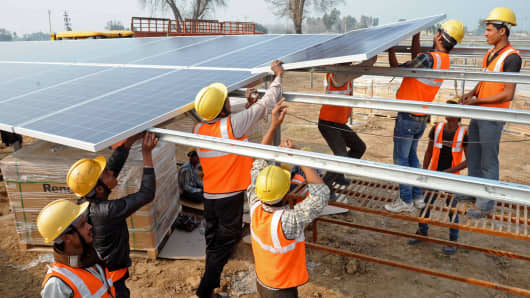
NARINDER NANU | AFP | Getty Images
A $20 billion joint venture aimed at Indian renewable energy is the latest sign of fresh investment in the sector as Prime Minister Narendra Modi seeks to aggressively boost output.
SoftBank, Bharti Enterprises and Taiwan's Foxconn Technologyrecently announced the creation of a joint venture firm called SBG Cleantech to develop alternative energy plants across India.
The move comes after India's cabinet approved a drastic increase in capacity targets. By 2022, Modi wants solar capacity at 100 gigawatts (GW), a fivefold increase from the previous target of 20GW. That averages to around 14GW a year, more than the amount of solar power added in the U.S. and China last year.
While the government has yet to explain how it plans to achieve such ambitious targets, overseas investment is expected to play an essential role.
"The Indian government with Modi on board has taken aggressive steps to accelerate renewable energy investment from foreign companies, and we anticipate more going forward," said Holly Hu, senior analyst at IHS Technology.
Indeed, the sector has witnessed a flurry of recent activity. Earlier this month, U.S. solar tech provider SunEdison said it planned to commit $15 billion to the country over the next seven years, as well as invest $2 billion in a joint venture with India's Adani Group to set up a factory. Meanwhile, Modi's recent visit to China last month yielded several memorandums of understandings (MOUs), setting the stage for an influx of mainland investment.
India permits 100 percent foreign direct investment in the renewables sector, but overseas companies still prefer to enter the market through joint ventures (JVs), explained Hu.
"For an emerging market like India, there's more risk and transparency issues involved so foreign investors want a partner. The government also prefers JVs so they can expand local presence."
Moreover, Indian interest rates are high relative to the rest of the world so companies would rather use foreign bank loans to get low rates, she added.
Compelling fundamentals
India's solar industry is expected to grow by 250 percent this year, putting the country on track to overtake Germany and enter the top five solar markets globally in the next three years, according to solar intelligence firm Bridge to India.
"Given its vast population, high irradiation, growing energy demand and power deficit, limited access to fossil fuels and a large number of unlit villages, India has great potential to be a major solar market," SoftBank echoed in an official statement.
A series of domestic policy announcements like mandatory solar rooftops on buildings and the construction of solar parks also paint a favorable outlook, signaling the extent of Modi's commitment.
Challenges at hand
Despite the near-frenzied level of interest in the sector, India has made slow progress, with only 4GW of solar power capacity installed since September 2013, noted IHS' Hu. In contrast, China added 5GW of solar power in the first three months of this year, according to government figures.
To achieve its capacity targets, New Delhi must ease land acquisition requirements, lower costs of financing and enforce long-term policies that can attract consistent investments, Deutsche Bank noted in a report earlier this year.
"Recent announcements from private companies coupled with talk of further cooperation with the U.S. and local policy announcements support our view that India is beginning to ramp installations and could become one of the top markets in the world," the report said.
Nyshka ChandranAssociate Producer, CNBC Asia-Pacific
RELATED SECURITIES
Symbol
|
Price
|
Change
|
%Change
| |
|---|---|---|---|---|
| 9984.T | 7209.00 | -36.00 | -0.50% |
ASIA TOMORROW
ABOUT ASIA TOMORROW
As emerging Asia transitions into a global economic power, it faces a host of challenges including rising inequality, increasing geo-political tensions, graying nations and climate change. We look how the world's most populous region is coping with the unprecedented changes, what policymakers are doing and what this means for businesses and investors.















No comments:
Post a Comment
Please leave a comment-- or suggestions, particularly of topics and places you'd like to see covered